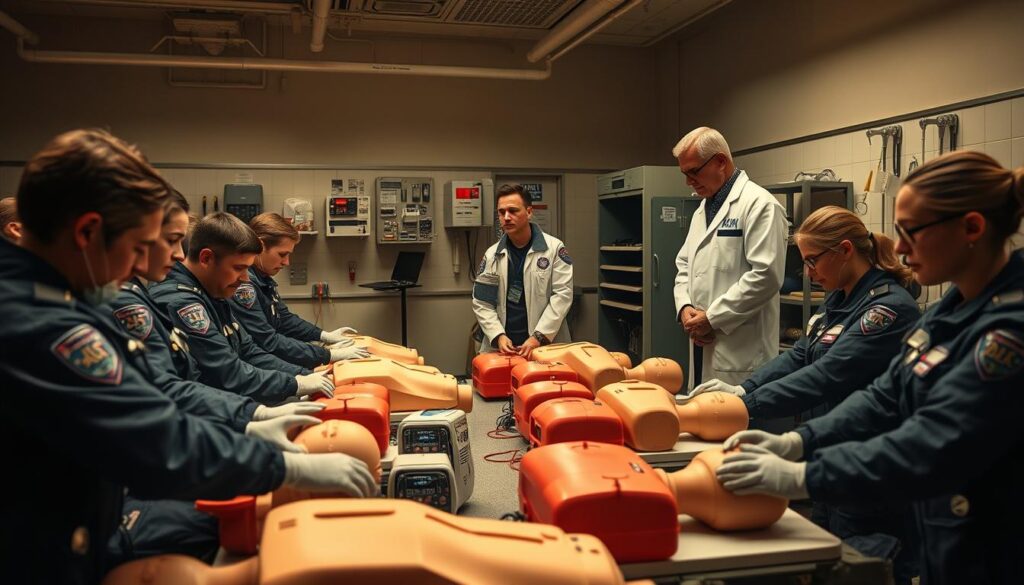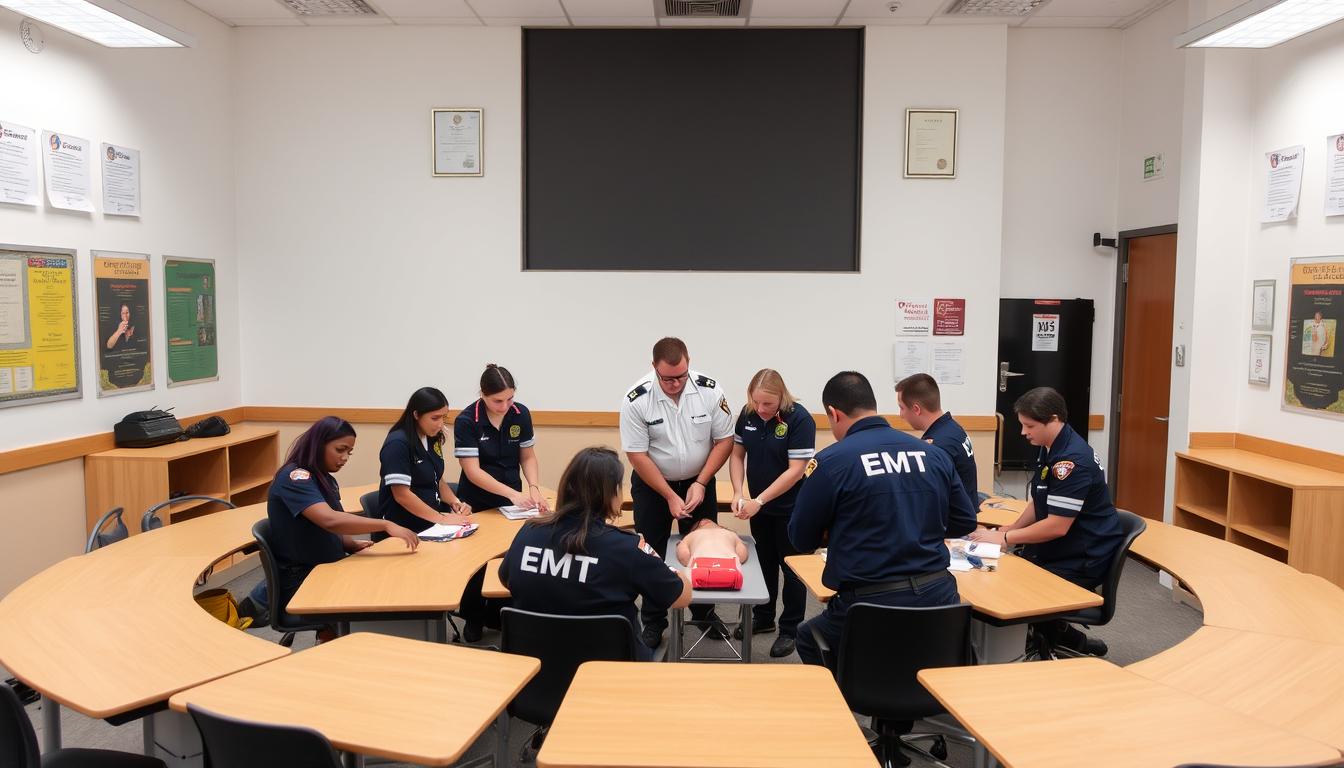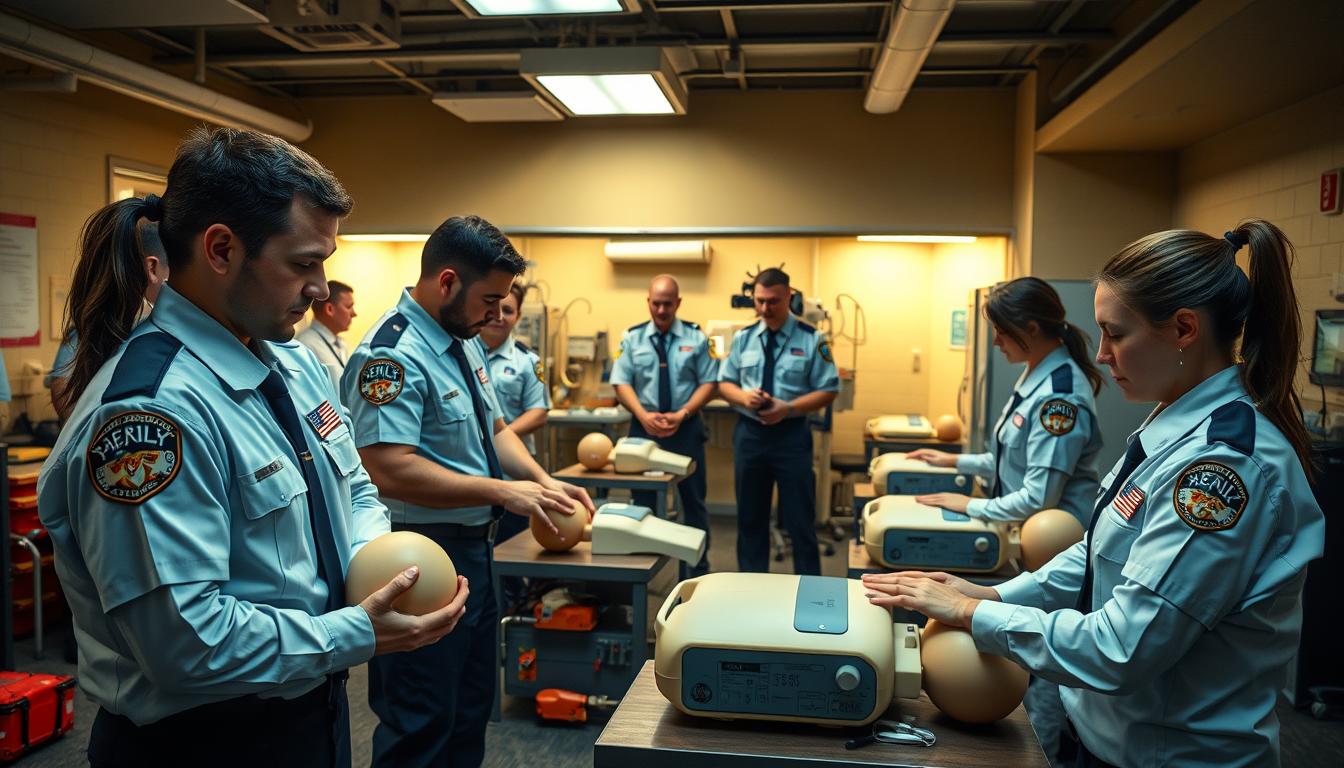EMT Schools Near Me are increasingly relevant as the demand for Emergency Medical Technicians (EMTs) is expected to grow by 11% through 2030, faster than the average for all occupations. This surge is driven by an aging population and an increased need for emergency services.
Enrolling in a local EMT school can be your first step towards a rewarding career in emergency medical services. By choosing a program near you, you can quickly gain the skills and certifications needed to succeed.
With the right training, you’ll be equipped to provide critical care in emergency situations. Starting your EMT career is within reach; find a program that fits your needs and start your journey today.
Understanding EMT Training and Certification
Understanding the intricacies of EMT training and certification is essential for aspiring emergency medical technicians. EMT training is a critical step in preparing individuals for a career in emergency medical services.
What EMT Training Involves
EMT training programs are designed to equip students with the necessary skills and knowledge to handle emergency medical situations. The training includes comprehensive coursework in patient assessment, trauma care, and medical emergencies. Students also learn about proper patient handling and transportation techniques.
Different EMT Certification Levels
There are different levels of EMT certification, including EMT-Basic, EMT-Intermediate, and EMT-Paramedic. Each level represents a progression in the complexity of care that an EMT can provide. EMT-Basic is the entry-level certification, while EMT-Paramedic is the most advanced level, requiring significantly more training and expertise.
Time Commitment and Prerequisites

The time required to complete EMT training varies depending on the certification level. EMT-Basic training typically requires around 120-150 hours of training, which can be completed in a few months. Prerequisites often include a high school diploma or equivalent, CPR certification, and a background check.
Finding the Best EMT School Near Me
To fast-track your emergency medical career, finding an accredited EMT program is essential. With numerous options available, it’s crucial to know what to look for in an EMT training program.
Types of EMT Training Programs Available
EMT training programs come in various formats, including online courses, in-person training, and hybrid models that combine both. The nearest EMT courses to you might offer different certification levels, such as EMT-Basic, EMT-Intermediate, or Paramedic training. Understanding these options is vital to selecting a program that fits your career goals and learning style.

Evaluating Accreditation and Program Quality
When searching for the best EMT schools, accreditation is a critical factor. Look for programs accredited by recognized bodies such as the Commission on Accreditation of Allied Health Education Programs (CAAHEP). Additionally, consider factors like program length, curriculum, and the qualifications of instructors to ensure you’re getting a high-quality education.
Cost Considerations and Financial Aid Options
The cost of EMT training can vary significantly. It’s essential to explore financial aid options, including scholarships, grants, and student loans. Some EMT programs may also offer tuition reimbursement or assistance with certification fees. By understanding the total cost and available financial aid, you can make an informed decision that aligns with your budget.
What to Expect During Your EMT Education
As you consider EMT classes nearby, understanding the structure of EMT education is crucial. EMT training programs are designed to provide a comprehensive education that includes both theoretical knowledge and practical skills.
Classroom Learning Components
The classroom component of EMT education covers the foundational knowledge required for emergency medical services. Students learn about patient assessment, trauma care, medical emergencies, and other critical topics. This phase is essential for building a strong understanding of EMT principles.
Hands-On Skills Training
In addition to classroom learning, EMT training center programs emphasize hands-on skills training. This practical training allows students to apply their knowledge in simulated emergency scenarios, practicing skills such as CPR, splinting, and patient assessment.
Clinical Rotations and Field Experience
Clinical rotations and field experience are critical components of EMT education. Students gain real-world experience by working alongside experienced EMTs and healthcare professionals in various settings, including hospitals and ambulances. This hands-on experience is invaluable for preparing students for the challenges of the EMT role.
| Component | Description | Importance |
|---|---|---|
| Classroom Learning | Theoretical foundation in EMT principles | High |
| Hands-On Skills Training | Practical application of EMT skills | High |
| Clinical Rotations and Field Experience | Real-world experience in emergency medical services | Very High |
Conclusion: Launching Your Emergency Medical Career
Now that you’ve explored the world of EMT training, it’s time to take the next step. Finding the right EMT school is crucial to launching a successful emergency medical career. When you find EMT training that fits your needs, you’ll be well on your way to becoming a certified EMT.
To find EMT training programs near you, consider factors like accreditation, program quality, and cost. By choosing a reputable EMT school, you’ll gain the skills and knowledge needed to excel in this rewarding field.
Take the first step towards a fulfilling career in emergency medicine. Start your journey today by searching for EMT training programs that align with your goals and aspirations.
FAQ
What are the prerequisites for enrolling in an EMT certification program?
Prerequisites for EMT certification programs typically include being at least 18 years old, having a high school diploma or equivalent, and possessing a valid driver’s license. Some programs may also require CPR certification, EMT certification at a lower level, or completion of a preparatory course.
How long does it take to complete EMT training?
The duration of EMT training varies depending on the certification level. EMT-Basic training typically takes around 120-150 hours, which can be completed in a few months. EMT-Intermediate and EMT-Paramedic training require more hours and can take up to a year or more to complete.
What is the difference between EMT-Basic, EMT-Intermediate, and EMT-Paramedic?
EMT-Basic training focuses on basic life support skills, such as patient assessment and trauma care. EMT-Intermediate training builds on these skills and adds more advanced techniques, such as IV therapy and medication administration. EMT-Paramedic training is the most advanced level, preparing students to provide complex care, including interpreting electrocardiograms and administering medications.
How do I find accredited EMT programs near me?
You can search for accredited EMT programs near you by visiting the Commission on Accreditation of Allied Health Education Programs (CAAHEP) or the National Registry of Emergency Medical Technicians (NREMT) websites. You can also search online for “EMT school near me” or “EMT certification programs near me” to find local training centers.
Are there financial aid options available for EMT training?
Yes, many EMT training programs offer financial aid options, such as scholarships, grants, and loans. You can also check with local hospitals, EMS agencies, or government organizations for potential funding opportunities. Some programs may also offer tuition reimbursement or assistance with certification fees.
What kind of job opportunities are available after completing EMT training?
After completing EMT training, you can work as an EMT in various settings, such as ambulance services, hospitals, fire departments, or private companies. You can also pursue specialized roles, such as flight medic or tactical EMT, or move into supervisory or management positions.
How do I maintain my EMT certification?
To maintain your EMT certification, you must complete continuing education requirements and adhere to the certification renewal policies set by the NREMT or your state’s EMS agency. This typically involves completing a certain number of hours of training or education within a specified timeframe.




